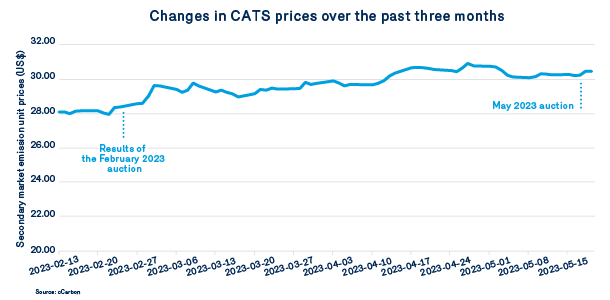Changes in Cap-and-trade system (CATS) prices over the past three months
After a relatively stable start to the year with prices between US$27.73 and US$29.99, the price of emission units surpassed the US$30 mark in April 2023 with a peak at US$31.13 on April 27. Throughout the month of May, the price ranged from US$30.20 to US$30.93.
As of May 22, 2023, the price of emission units on the secondary market was US$30.61 (C$41.34), or US$8.40 (38%) above the floor price of US$22.21 (C$29.99).
Despite these variations, the market has not experienced a major event that has significantly affected prices since the beginning of 2023. The most notable event was the announcement of potential joint regulatory reviews by Quebec and California, made in late February 2023. This announcement came just days after results were released for the first auction of the year, held in February. At that auction, emission unit sale prices were set at US$27.85 (C$37.17) for the current vintage and US$27.01 (C$36.04) for the future vintage.
Without fundamental factors directly influencing the secondary market, the latter continues to be influenced by external factors from other financial markets, namely movements in interest rates and inflation, which are still high. The consequences of the war in Ukraine also continue to be an element of widespread uncertainty on the markets.

May 2023 auction results
The second auction of 2023 was held on May 17, 2023. The final sale price of emission units for the current vintage has been set at US$30.33 (C$40.81), while the price of emission units for the future vintage has been set at US$30.05 (C$40.44). The ratio of accepted offers to the number of units sold at the time of the sale was 175% for the current vintage and 263% for the future vintage. These ratios indicate relatively strong market demand for emission units, particularly for the future vintage.
Reminder: Reserve consigned funds before September 1!
Under the Regulation respecting a cap-and-trade system for greenhouse gas emission allowances (RSPEDE), updated in September 2022, a portion of emission allowances resulting from the reduction of the free allowance level will be set aside. The proceeds from the auction of these units will be reserved for businesses to finance projects or to cover the additional costs associated with renewable energy consumption as part of the climate transition.
To reserve consigned funds as early as 2024, emitters must sign an agreement with the ministry before September 1, 2023.
For the large emitters concerned, eligible projects include studies on the techno-economic potential to reduce GHG emissions, GHG emission reduction projects, and tech innovation projects with a focus on reducing GHG emissions.
Eligible expenses include additional operating costs associated with converting to renewable natural gas.
The project application process is available on the ministry’s website.
For more information, contact the Ministère de l’Environnement at: [email protected].
2023–2028 Implementation Plan for Quebec’s Plan for a Green Economy
On May 19, the Government of Quebec released its 2023-2028 Implementation Plan (French) for the 2030 Plan for a Green Economy (2030 PGE). This is the second revision of its 2030 PGE five-year implementation plan.
The 2023-2028 Implementation Plan will invest an additional $9 billion over 5 years. This represents an increase of almost $1.4 billion over the fiscal framework of the 2022-2027 Implementation Plan.
In addition to sustainable mobility and climate change adaptation measures, additional investments are planned to decarbonize industry and improve energy performance in buildings through initiatives such as the dual-energy (+$175 million), Chauffez vert (+$129.3 million) and thermal recovery (+$53 million) programs.
Information on how to participate in these programs is available on the government website.
Public consultation on draft regulation respecting anaerobic digestion projects eligible for the issuance of offset credits
The Government of Quebec held public consultations from April 5 to May 22, 2023, on the draft offset regulation for slurry biomethane projects eligible for offset credits.
The purpose of the proposed regulation is to open offset credit eligibility under CATS to hog and cattle slurry biomethane projects originating from Quebec farming businesses equipped with a slurry liquid waste management system (slurry pit), notably to encourage the implementation of these types of projects.
Among other things, the draft sets out conditions under which a slurry biomethane project is eligible for offset credits, as well as the general conditions for implementing this type of project.
The draft regulation is available on the Quebec government’s website (in French).

